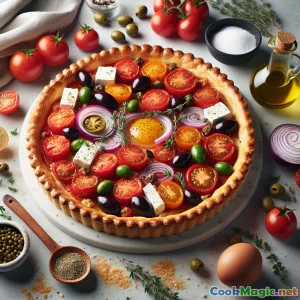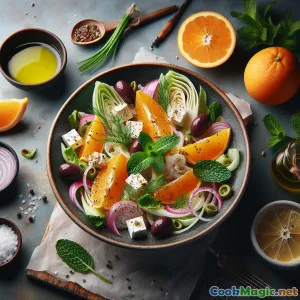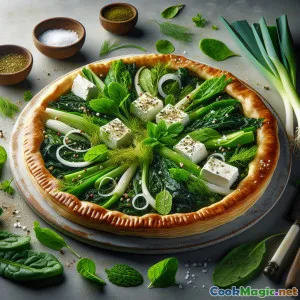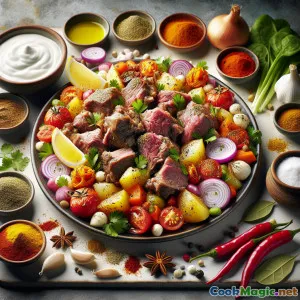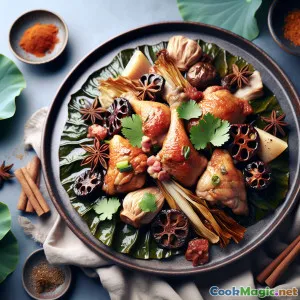
Cơm pilaf lúa mạch nghệ tây kiểu Cycladic với chanh và thảo mộc
(Cycladic Saffron Barley Pilaf with Lemon and Herbs)
(0 Đánh giá)0
12
tháng 11 12, 2025
Báo cáo sự cố
Nguyên liệu
-
250 grams Lúa mạch thủ lòng đào
(Rinse briefly to remove dust; pearled cooks faster than hulled.)
-
0.25 grams Saffron
(Use high-quality Greek saffron for vivid color and aroma.)
-
900 ml Nước dùng rau củ ít natri
(Warm before adding to keep the simmer steady.)
-
80 ml rượu vang trắng khô
(Assyrtiko if available; replace with extra broth if avoiding alcohol.)
-
3 tbsp Dầu ô liu nguyên chất
(Fruity Aegean-style olive oil preferred.)
-
1 medium Hành vàng
(Finely diced for even sweetness.)
-
3 cloves Tỏi
(Băm nhỏ.)
-
1 leaf Lá nguyệt quế
(Adds subtle herbal depth.)
-
150 grams Cà chua bi
(Halved; adds juicy brightness.)
-
2 tbsp Những quả caper
(Rinsed to moderate salinity; Cycladic pantry staple.)
-
1 large Chanh
(Use both zest and juice.)
-
2 tbsp Thì là tươi
(Băm nhuyễn.)
-
2 tbsp Ngò tây lá phẳng tươi
(Băm nhuyễn.)
-
0.5 tsp Muối biển
(Adjust to taste, especially if adding feta.)
-
0.5 tsp Tiêu đen xay mới
(Adds gentle heat.)
-
60 grams Phô mai Feta
(Crumbled for serving; omit for vegan.)
-
20 grams Hạnh nhân lát rang
(For crunch and nuttiness.)
-
4 wedges Miếng chanh
(Để phục vụ.)
-
2 tbsp Rau thì là thì là
(Optional aromatic garnish if available.)
(Rinse briefly to remove dust; pearled cooks faster than hulled.)
(Use high-quality Greek saffron for vivid color and aroma.)
(Warm before adding to keep the simmer steady.)
(Assyrtiko if available; replace with extra broth if avoiding alcohol.)
(Fruity Aegean-style olive oil preferred.)
(Finely diced for even sweetness.)
(Băm nhỏ.)
(Adds subtle herbal depth.)
(Halved; adds juicy brightness.)
(Rinsed to moderate salinity; Cycladic pantry staple.)
(Use both zest and juice.)
(Băm nhuyễn.)
(Băm nhuyễn.)
(Adjust to taste, especially if adding feta.)
(Adds gentle heat.)
(Crumbled for serving; omit for vegan.)
(For crunch and nuttiness.)
(Để phục vụ.)
(Optional aromatic garnish if available.)
Dinh dưỡng
- Khẩu phần: 4
- Kích thước khẩu phần: 1 bát (300g)
- Calories: 370 kcal
- Carbohydrates: 51 g
- Protein: 9 g
- Fat: 13 g
- Fiber: 12 g
- Sugar: 3 g
- Sodium: 520 mg
- Cholesterol: 0 mg
- Calcium: 80 mg
- Iron: 2.2 mg
Hướng dẫn
-
1 - Bloom the Saffron:
Warm the broth until just steaming. Ladle 120 ml into a cup and add saffron threads. Let steep to release color and aroma.
-
2 - Prep barley and aromatics:
Rinse barley in cold water and drain well. Finely dice onion, mince garlic, halve tomatoes, and chop dill and parsley. Zest lemon, then cut and juice it.
-
3 - Sweat the onion and garlic:
Heat olive oil in a wide saucepan over medium heat. Add onion and a pinch of salt; cook until translucent. Stir in garlic for 30 seconds until fragrant.
-
4 - Toast the barley:
Add drained barley to the pan. Stir to coat in oil and toast lightly until nutty aromas emerge.
-
5 - Deglaze:
Pour in white wine and cook, scraping the pan, until mostly evaporated. If skipping wine, add a splash of broth instead.
-
6 - Simmer Gently:
Add the saffron-infused broth and remaining hot broth along with the bay leaf. Bring to a soft simmer, cover, and cook until barley is tender-chewy, stirring once or twice.
-
7 - Add tomatoes and capers:
Fold in cherry tomatoes and capers. Continue simmering uncovered until tomatoes slump slightly and liquid is mostly absorbed.
-
8 - Finish with lemon and herbs:
Remove bay leaf. Stir in lemon zest, half the lemon juice, dill, and parsley. Season with salt and black pepper. Add more lemon to taste.
-
9 - Rest and Fluff:
Turn off heat, cover, and rest to let grains relax. Fluff gently with a fork for a plush pilaf texture.
-
10 - Garnish and Serve:
Plate the pilaf. Top with crumbled feta and almonds if using, scatter fennel fronds, and serve with lemon wedges.
Warm the broth until just steaming. Ladle 120 ml into a cup and add saffron threads. Let steep to release color and aroma.
Rinse barley in cold water and drain well. Finely dice onion, mince garlic, halve tomatoes, and chop dill and parsley. Zest lemon, then cut and juice it.
Heat olive oil in a wide saucepan over medium heat. Add onion and a pinch of salt; cook until translucent. Stir in garlic for 30 seconds until fragrant.
Add drained barley to the pan. Stir to coat in oil and toast lightly until nutty aromas emerge.
Pour in white wine and cook, scraping the pan, until mostly evaporated. If skipping wine, add a splash of broth instead.
Add the saffron-infused broth and remaining hot broth along with the bay leaf. Bring to a soft simmer, cover, and cook until barley is tender-chewy, stirring once or twice.
Fold in cherry tomatoes and capers. Continue simmering uncovered until tomatoes slump slightly and liquid is mostly absorbed.
Remove bay leaf. Stir in lemon zest, half the lemon juice, dill, and parsley. Season with salt and black pepper. Add more lemon to taste.
Turn off heat, cover, and rest to let grains relax. Fluff gently with a fork for a plush pilaf texture.
Plate the pilaf. Top with crumbled feta and almonds if using, scatter fennel fronds, and serve with lemon wedges.
Thông tin thêm về: Cơm pilaf lúa mạch nghệ tây kiểu Cycladic với chanh và thảo mộc
About Cycladic Saffron Barley Pilaf
Golden and aromatic, this pilaf draws inspiration from the sun-washed Cycladic islands where cooking is guided by wind, sea, and frugality. Barley, one of Greece’s oldest grains, provides a toothsome foundation, while saffron lends its unmistakable floral fragrance and luminous hue. Briny Cycladic capers, bright lemon, and a garden scatter of dill and parsley complete a dish that feels both rustic and refined.
Flavor and texture
Expect a balance of savory and citrusy elements: the nuttiness of barley, the honeyed perfume of saffron, gentle sweetness from slow-sweated onions, and little bursts of briny caper. Cherry tomatoes collapse into juicy pockets that glaze the grains. The final drizzle of olive oil and fresh herbs gives lift and sheen. Properly cooked, barley remains tender-chewy, a satisfying contrast to the plush pilaf consistency.
Technique highlights
- Bloom saffron: Steeping the threads in warm broth releases color and volatile aromas more effectively than adding them dry. The entire dish takes on a deep golden tone.
- Toast the grain: Briefly toasting barley in olive oil coaxs a nuttier profile and helps keep grains separate.
- Gentle simmer: Barley benefits from a patient, covered simmer. Stir just once or twice so starches thicken the sauce without turning gluey.
- Rest and fluff: Off-heat resting lets moisture redistribute, resulting in a pillowy pilaf.
Ingredient notes and smart swaps
- Saffron: Greek saffron from Kozani is prized for potency; a small pinch goes far. If saffron is unavailable, a pinch of turmeric can mimic color but not aroma.
- Capers: Cycladic islands like Santorini are known for their capers. Rinse to moderate salinity; keep some brine if you enjoy sharper bite.
- Barley alternatives: Farro or freekeh deliver similar chew and cooking times. For a gluten-free version, use short-grain brown rice and extend cooking as needed.
- Wine: Assyrtiko offers bright acidity and mineral notes. Replace with extra broth and a splash of lemon juice if avoiding alcohol.
- Cheese and crunch: Feta and toasted almonds are optional but recommended for contrast. For vegan, omit feta and add olives or roasted chickpeas.
Serving ideas
- As a vegetarian main: Top with extra herbs, almonds, and a drizzle of bold olive oil. Add roasted zucchini or eggplant for a heartier plate.
- With seafood: Pairs beautifully with simple grilled sea bream, shrimp skewers, or pan-seared calamari.
- With salads: Serve alongside a classic Greek salad or shaved fennel and orange salad to echo the anise notes of fennel fronds.
Make-ahead and storage
This pilaf holds well and reheats beautifully. Refrigerate leftovers in a sealed container for up to 4 days. Rewarm over low heat with a splash of water or broth to loosen. The flavors deepen overnight, making it ideal for meal prep or the next day’s lunch.
Cultural thread
Barley has deep roots in Greek antiquity, fueling athletes and farmers alike. On the islands, cooks historically relied on shelf-stable grains, preserved fish, and salt-cured accents like capers to outlast windswept winters. Saffron is not native to the Cyclades, but the Greek strands from Kozani are the country’s golden pride and knit seamlessly into island cooking, marrying ocean brine, citrus, olive oil, and herbs.
Tips for success
- Salt with restraint: Capers and any added feta bring salinity. Taste before finishing with additional salt.
- Control the simmer: Boiling can burst grains. Keep it gently active for even texture.
- Lemon in layers: Zest for aroma, juice for brightness. Add partway through finishing, then adjust at the end.
- Herb timing: Stir most herbs in off heat to preserve color and freshness; reserve a pinch for garnish.
Sustainability and economy
Barley is hardy, affordable, and nutritionally dense, offering ample fiber and minerals. Using low-sodium broth, seasonal herbs, and pantry-friendly capers makes this dish both budget-conscious and weeknight-accessible, yet it still feels special enough for guests thanks to saffron’s aroma and color.
Personal note
This pilaf conjures the Cycladic palette: whitewashed walls, sapphire seas, and pathways perfumed by citrus and wild herbs. Every bite feels like a breeze off the Aegean—clean, briny, bright. It is a dish that proves a few well-chosen ingredients, cooked with care, can travel far on the plate and in memory.




